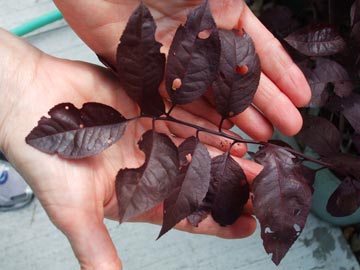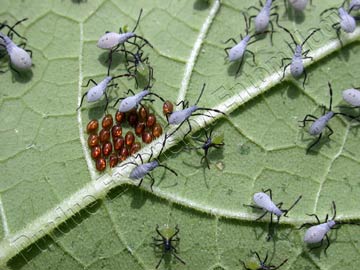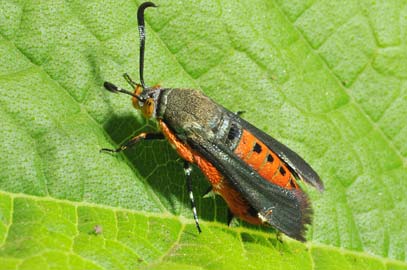Celebrate the Leaf Cutter Bee
Most insects are not harmful, even though they may damage plants. The damage is cosmetic rather than deadly. A good example is the native leaf cutter bee.
 Harmless and beneficial leaf cutter bees chew neat and tidy circles from the leaves of sand cherry, redbud, false indigo and many other trees, shrubs and perennials.
Harmless and beneficial leaf cutter bees chew neat and tidy circles from the leaves of sand cherry, redbud, false indigo and many other trees, shrubs and perennials.
Jo Ellen Meyers Sharp
This tiny bee is harmless. It rarely stings. It is an efficient pollinator in gardens and farm fields. You know it’s around because – true to its name – the bee cuts out neat circular pieces from the leaves of redbud, sand cherry, coneflower and other trees, shrubs and perennials. The bees use these leafy disks to build their nests. Be grateful you have this hard worker in your garden. And although alarming, a bee that cuts circles in plants is a harmless, efficient pollinator in the garden.
Squash Bugs
Probably the greatest nemeses in the vegetable garden are two insects that prefer the squash family. The squash bug is especially damaging to young plants of zucchini, melons, pumpkins and other members of the cucurbit family. These insects pierce the leaves of squash-family plants and suck out nutrients. Heavy feeding can kill young plants and damage more mature ones.
 Look for squash bug eggs and nymphs on the undersides of leaves.
Look for squash bug eggs and nymphs on the undersides of leaves.
John Obermeyer/Purdue Extension Entomologist
Tips for Controlling Squash Bugs:
- Monitor the undersides of leaves to look for their eggs. They are oval shaped and usually brown. Put on a glove and squish them, or knock them off into a bucket of soapy water.
- If the eggs have hatched, the nymphs have a blue cast. Squish them or knock them off, as described above.
- Place boards or newspapers in the bed, where the bugs will congregate at night. Gather and destroy or discard in the morning.
- The adult squash bug looks a bit like a stink bug. Knock it into the soapy water. Insecticides usually are not needed to control squash bugs. Squash bugs are not considered a pest later in the season.
- Remove and destroy any severely damaged or dead plants. Be sure to clean up the area in the fall.
Squash Vine Borer
 Monitor squash plants regularly to prevent the squash vine borer moth from laying eggs.
Monitor squash plants regularly to prevent the squash vine borer moth from laying eggs.
John Obermeyer/Purdue Extension Entomologist
Another insect that has a preference for members of this family is the squash vine borer. A rather attractive moth lays eggs at the base of squash, pumpkin, melon and other plants in the family. The eggs hatch and the larva bores into the stem. Eventually the plant wilts and collapses because the stem no longer can take up water.
Tips for Controlling Squash Vine Borer:
- Monitor plants for the adult moth, or the tiny larva at the base of the plant. Destroy when discovered.
- Protect the plants with a fabric row cover as soon as they begin to vine. A row cover allows water and sunlight to reach the soil and plants, but blocks out insects. Keep the row cover in place for about two weeks.
- Do not use a row cover if squash was planted in the same place last year. Because the moth pupates under ground in winter, it’s possible to trap the emerging moths under the row cover.
- If the plants have begun to bloom, you cannot use a row cover because bees and other pollinators can’t get to the flowers. No pollination, no squash, melons or cucumbers.
Best Defense Practices
Rotate crops annually to reduce these and other problems. Remove and destroy any severely infested, damaged or dead plants as soon as they are discovered. Be sure to remove any plant debris from the garden in fall clean up, especially in areas where insects or diseases were problems.
Of course, the best defense against any attack from insects (or many diseases) is to have healthy plants growing in a good environment. Make a plant fertilizer that's rich in organic nutrients part of your arsenal to protect plants by keeping them healthy.